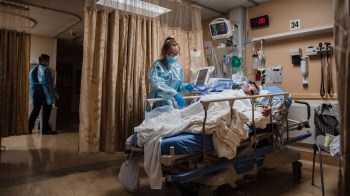
Rural paramedics are making routine house calls to avoid costly emergency room visits
Rural paramedics are making routine house calls to avoid costly emergency room visits

In some rural parts of the U.S., where hospitals and doctors’ offices are in short supply, people often turn to calling 911 just for basic medical care.
Experts say that’s a problem for patients and hospitals, but a growing model called community paramedicine aims to address it by having paramedics regularly check in on people before a health issue turns into an emergency.
One of those programs is playing out in the tiny desert town of Terlingua, Texas, where Susan Martin is chief of the local emergency medical services department. Her small crew, fewer than 10 people, responds to 911 calls across a dusty, 3,000-square-mile range of rural West Texas.
“A lot of what we’re seeing now with the heat is environmental: some dehydration, some heat exhaustion, things like that,” she said.
Martin said they also get calls from people with chronic health issues.
“Some patients don’t understand their medications,” she said. “[As in] ‘They don’t make me feel good so I don’t want to take them, so I don’t take them, then I end up being a 911 call.'”
The closest hospital is more than an hour away, so the local EMS team’s single ambulance can be tied up for a good chunk of the day on an emergency call.
That’s a big part of why Martin’s team has launched a “community paramedicine” program, where paramedics regularly check in on people with known health issues — patients who might not get to the doctor as often as they should.
“A lot of people out here, they’re very like, reclusive,” said Alexandria Hollenbeck, one of the local paramedics. “It tends to be older people, or people with chronic illnesses, such as hypertension, COPD.”
A 2023 survey from a national paramedics trade group counted more than 150 of these kinds of community paramedicine programs across the country. It’s a growing health care model championed by EMS agencies and hospitals at a time when some advocates say rural health care is facing a crisis.
Adrian Billings is a longtime West Texas doctor and rural health expert at Texas Tech University.
“This area is one of the most under-resourced health care areas in our state,” he said.
For patients, Billings said, routine paramedicine check-ins at home can avoid expensive emergency room visits. Hospitals want to avoid that too, as they can face penalties when too many patients come back to the emergency room soon after release. That’s called a readmission.
“From a financial standpoint, community paramedicine programs do help cut down on readmissions that can be very costly for hospitals,” Billings said.
One KFF Health News analysis from 2022 tallied $320 million in hospital readmission penalties nationwide.
But even though paramedicine programs can save big on costs, preventative care like this requires an upfront investment.
“The economic model for EMS-based community paramedicine is very challenging.” said Matt Zavadsky, a longtime emergency medicine professional in Texas who now works for a national consulting firm for EMS operations.
He said insurance providers — Medicare, Medicaid and private insurers — mostly don’t cover paramedics making house calls.
“So we’ve got EMTs and paramedics all over the country who are doing the right thing by trying to work with patients to prevent unnecessary emergency department visits, but yet they’re not eligible for reimbursement,” he said.
The new paramedicine program in small-town Terlingua is being funded as part of a broader $5 million U.S. Department of Agriculture rural development grant, with no guarantees for long-term funding.
“Being able to prove to the payers that these programs are economically more efficient than a 911 call to the emergency department is going to be crucial for those rural communities to sustain these outstanding programs,” Zavadsky said.
He hopes that with time and data, community paramedicine programs will be able to prove their worth to health care insurers.
There’s a lot happening in the world. Through it all, Marketplace is here for you.
You rely on Marketplace to break down the world’s events and tell you how it affects you in a fact-based, approachable way. We rely on your financial support to keep making that possible.
Your donation today powers the independent journalism that you rely on. For just $5/month, you can help sustain Marketplace so we can keep reporting on the things that matter to you.

















